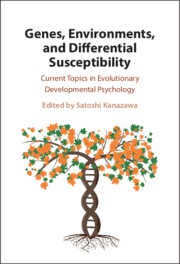
-
Select format
-
- Publisher:
- Cambridge University Press
- Publication date:
- September 2025
- September 2025
- ISBN:
- 9781009363914
- 9781009363952
- Dimensions:
- (229 x 152 mm)
- Weight & Pages:
- 0.57kg, 296 Pages
- Dimensions:
- Weight & Pages:
- Subjects:
- Developmental Psychology, Psychology
You may already have access via personal or institutional login- Subjects:
- Developmental Psychology, Psychology
Book description
The evolutionary perspective has influenced many subfields of psychology and related social sciences in the last three decades. However, developmental psychology has remained largely immune to evolutionary thinking. What does evolutionary thinking have to offer developmental psychology and the study of child development? This book invites some of the leading figures in evolutionary developmental psychology to discuss cutting-edge research and its significance in related fields. By laying out the utility and importance of evolutionary thinking in developmental science, each chapter shows how the evolutionary perspective both opens new avenues of research by posing novel questions and providing insightful answers to age-old questions and debates. In the process, their overviews pay particular attention to the theoretical and empirical contributions of Jay Belsky, a pioneering developmental psychologist who has paved the way forward for the field. A short tribute and biography follow the chapters to pay homage to his work.
Reviews
‘The profound and lasting impact of Jay Belsky’s work on developmental psychology is reflected in the chapters in this volume. Belsky’s pioneering research on the determinants of parenting, evolutionary developmental psychology, child maltreatment, attachment, and differential susceptibility to environmental influences, among other topics, continues to guide contemporary research and theory.’
David F. Bjorklund - Professor of Psychology, Florida Atlantic University
‘Kanazawa has assembled an all-star cast of scientists to celebrate the past and continuing contributions of one of psychology’s mavericks, Jay Belsky. Jay is one of the pioneers in the integration of psychological models of early development with evolutionary principles and this is a fitting tribute to his many contributions.’
David C. Geary - Curators’ Distinguished Professor, University of Missouri
‘This is a wonderful book, containing chapters written by leaders in developmental psychology and psychopathology, highlighting the amazing richness, scope, and depth of Jay Belsky’s groundbreaking contributions, while illustrating how powerfully and broadly his work has inspired and transformed our thinking about development. A remarkable volume - a fitting tribute to a remarkable career!’
Grazyna Kochanska - Dewey B. Stuit Professor, University of Iowa
‘The breadth of chapters is impressive, written by leading figures, covering diverse topics such as childcare, child maltreatment, attachment, differential susceptibility, evolutionary perspectives in developmental sciences (to name but a few). The volume provides evidence for a groundbreaking scientific legacy, with so many implications. This is a book that every student and researcher must read, and it will become a classic.’
Abraham (Avi) Sagi-Schwartz - Emeritus Professor of Psychology, University of Haifa and Tel Hai College, Israel
Contents
Metrics
Altmetric attention score
Full text views
Full text views help Loading metrics...
Loading metrics...
* Views captured on Cambridge Core between #date#. This data will be updated every 24 hours.
Usage data cannot currently be displayed.
Accessibility standard: WCAG 2.0 A
Why this information is here
This section outlines the accessibility features of this content - including support for screen readers, full keyboard navigation and high-contrast display options. This may not be relevant for you.
Accessibility Information
The PDF of this book conforms to version 2.0 of the Web Content Accessibility Guidelines (WCAG), ensuring core accessibility principles are addressed and meets the basic (A) level of WCAG compliance, addressing essential accessibility barriers.
Content Navigation
Table of contents navigation
Allows you to navigate directly to chapters, sections, or non‐text items through a linked table of contents, reducing the need for extensive scrolling.
Index navigation
Provides an interactive index, letting you go straight to where a term or subject appears in the text without manual searching.
Reading Order and Textual Equivalents
Single logical reading order
You will encounter all content (including footnotes, captions, etc.) in a clear, sequential flow, making it easier to follow with assistive tools like screen readers.
Short alternative textual descriptions
You get concise descriptions (for images, charts, or media clips), ensuring you do not miss crucial information when visual or audio elements are not accessible.
Full alternative textual descriptions
You get more than just short alt text: you have comprehensive text equivalents, transcripts, captions, or audio descriptions for substantial non‐text content, which is especially helpful for complex visuals or multimedia.
Visual Accessibility
Use of colour is not sole means of conveying information
You will still understand key ideas or prompts without relying solely on colour, which is especially helpful if you have colour vision deficiencies.
Use of high contrast between text and background colour
You benefit from high‐contrast text, which improves legibility if you have low vision or if you are reading in less‐than‐ideal lighting conditions.

